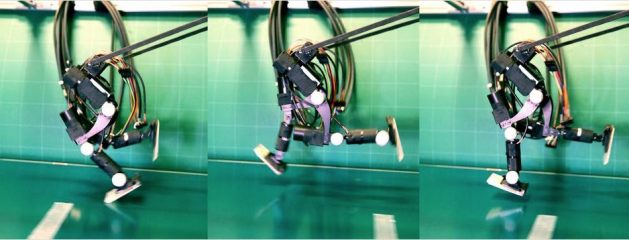
The Achillies robot is capable of running at 4.2 kph, the speed of an average human jogger. (Takeshi Tokitsu)
Scientists at the University of Tokyo announced Sept. 1 that they have developed a bipedal robot that can run like a human.
Led by Masatoshi Ishikawa, professor of systems informatics at the university’s Graduate School of Information Science and Technology, the team of engineers created the “Achilles” robot, which is capable of running at 4.2 kph, equivalent to the speed of a human jogging.
However, Achilles’ legs measure only 14 centimeters long. If extended to 70 cm, the length of an average human leg, the robot’s running speed would be about 10 kph.
Conventional bipedal robots, such as Honda Motor Co.’s ASIMO, can walk, but are unable to run because they walk by moving only their legs.
This movement differs significantly from the way humans run, as the upper torsos of the robots have to be kept erect to maintain stability.
Achilles can run because it can pivot its hip forward, intentionally losing its balance. But right before it loses too much balance and falls, the robot swings one of its legs forward to kick the ground.
This method of running is the same as a human being. It was achieved robotically by using a high-speed image processing system that enables Achilles to determine when it is about to fall, and a compact, lightweight actuator lets the robot swing its leg forward just in time.
As the robot runs, a camera films its movement at 600 frames per second and sends signals to the actuators in the machine’s numerous joints to turn them on or off at just the right moment.
In the near future, the team plans to develop a robot with a camera on its head that can jump over obstacles and play soccer.
Original story found at: http://ajw.asahi.com/article/sci_tech/technology/AJ201409020065




